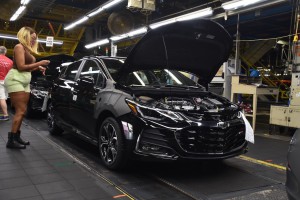
Could the Lordstown, Ohio plant be spared? Contract negotiations between the UAW and GM could bring it back to life.
Workers at General Motors’ Lordstown, Ohio plant may have reason to hope their prayers will be answered.
The automaker is dangling the possibility that the factory – one of five it plans to shutter next year – could be salvaged when GM and the United Auto Workers Union sit down to negotiate a new, five-year contract next summer.
“Plant closings are a matter of negotiations between GM and the United Auto Workers,” spokesman Pat Morrissey told TheDetroitBureau.com. “At this point, the plants are ‘unallocated,’” which, under the language of the current union/management contract, means there is still the possibility GM will move forward and allocate new product there as part of the next agreement.
That said, Morrissey took pains to stress that there are no easy alternatives for Lordstown or any of the other facilities GM is targeting as part of a broad restructuring announced on Nov. 26. The plan covers assembly plants in Ontario, Michigan and Ohio, as well as parts plants in Michigan and Maryland. Additionally, about 15% of GM’s white-collar workforce will be cut, bringing to about 15,000 the number of staff and contract jobs that are to be eliminated.
(Senators pressuring GM to halt $14B stock buyback plan. Click Here for the story.)
It would be routine for planned plant closures to be included in upcoming contract talks. And, throughout the years, GM and the UAW have found ways to salvage borderline operations, often by the union granting concessions meant to reduce labor costs or boost productivity. But such an approach could prove less effective this time.
The big problem for GM is that its product line-up is out of sync with the U.S. automotive market which has seen light trucks grow from slightly less than half of all new vehicle sales in 2008 to more than two-thirds this year. Demand for vehicles like the Chevrolet Cruze sedan built at the Lordstown plant has fallen commensurately. And as part of the restructuring, GM plans to eliminate six different sedan and hatchback models, including the Cruise, as well as the Buick LaCrosse and Cadillac CT6.
There are “a lot of different scenarios that could play out,” said spokesman Morrissey, noting that a number of other GM passenger car plants are also running well below capacity. One would see GM consolidate several slow-selling models into a single plant, such as Lordstown, to bring up capacity utilization. But that would likely mean that other factories would have to close.
Another option would be to allocate new products to plants set to shut down. Critics have demanded GM start by transferring production of the newly revived Chevrolet Blazer from a factory in Mexico to Lordstown or one of the other plants on the chopping block.
During a visit to Capitol Hill earlier this month, GM CEO Mary Barra appeared to rule that idea out. But she also told lawmakers from Michigan and Ohio that she was keeping an “open mind” about saving one or more of the targeted assembly plants.
Among the possibilities sources have pointed to, GM could move to add production of some of the battery-electric vehicles it is currently developing. How soon that could happen is uncertain, however.
(Click Here for more about GM CEO Mary Barra’s two-day D.C. tour.)
Lordstown, in particular, doesn’t have much time to wait for a miracle. Production of the six passenger car models being dropped will begin phasing out early in 2019 and be completed by the end of the year. First to go is the Cruze, which will be “unallocated” by the end of March.
There is little doubt that GM officials are feeling the heat that was ignited by the cutback announcement. The criticism has been unusually bipartisan, many echoing a tweet by Pres. Donald Trump in which he described himself as “very disappointed,” especially considering the federal bailout GM received after going bankrupt in 2010. “The U.S. saved General Motors and this is the thanks we get.”
“I understand (the cuts are) something that impacts the country and I understand that there is a lot of emotion and concern about it,” Barra told Reuters earlier this month.
Complicating the PR challenge for the automaker, Elon Musk, the CEO of Tesla, told an interviewer on CBS News that he would consider buying the Lordstown plant to add the additional capacity he claims the battery-electric manufacturer will soon need. Ohio Governor John Kasich responded with his own tweet asking Musk to “call me.”
The actual job losses resulting from GM’s restructuring might be less than initially announced, even if all five plants close.
(To see more about Mary Barra’s radical reshaping of General Motors, Click Here.)
“Over 1,100 employees at the various plants (on the chopping block) have indicated they would be interested in moving to another plant,” said spokesman Morrissey, noting that there more than 1,000 jobs that could open up at a truck plant in Flint, Michigan alone.
